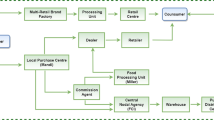Abstract
Food fraud has an adverse impact on all stakeholders in the food production and distribution process. Lack of transparency in food supply chains is a strong factor contributing to food fraud. With limited transparency, the insights on food supply chains are fragmented, and every participant has to rely on trusted third parties to assess food quality. Blockchain has been introduced to the food industry to enable transparency and visibility, but it can only protect the integrity of a digital representation of physical food, not the physical food directly. Tagging techniques, like barcodes and QR codes that are used to connect the physical food to its digital representation, are vulnerable to attacks. In this paper, we propose a blockchain-based solution to link physical items, like food, to their digital representations using physical attributes of the item. This solution is generic in its support for different methods to perform the physical checks; as a concrete example, we use machine learning models on visual features of food products, through regular and thermal photos. Furthermore, we use blockchain to introduce a reward system for supply chain participants, which incentivizes honesty and supplying data. We evaluate the technical feasibility of components of this architecture for food fraud detection using a real-world scenario, including machine-learning models for distinguishing between grain-fed and grass-fed beef.
Access this chapter
Tax calculation will be finalised at checkout
Purchases are for personal use only
Similar content being viewed by others
References
Food fraud vulnerability assessment and mitigation-are you doing enough to prevent food fraud? Technical report, PWC (2016)
Fleder, M., Kester, M.S., Pillai, S.: Bitcoin transaction graph analysis. arXiv preprint arXiv:1502.01657 (2015)
Lo, S.K., Xu, X., Chiam, Y.K., Lu, Q.: Evaluating suitability of applying blockchain. In: The 22nd ICECCS, November 2017
Osorio, M.T., Moloney, A.P., Schmidt, O., Monahan, F.J.: Beef authentication and retrospective dietary verification using stable isotope ratio analysis of bovine muscle and tail hair. J. Agric. Food Chem. 59(7), 3295–3305 (2011)
Staples, M.: Risks and opportunities for systems using blockchain and smart contracts. Technical report, Data61 (CSIRO), Sydney (2017)
Tian, F.: A supply chain traceability system for food safety based on HACCP, blockchain & internet of things. In: The 14th International Conference on Service Systems and Service Management, June 2017
Uludag, U., Pankanti, S., Prabhakar, S., Jain, A.K.: Biometric cryptosystems: issues and challenges. Proc. IEEE 92(6), 948–960 (2004)
Xu, X., Lu, Q., Liu, Y., Yao, H., Zhu, L., Vasilakos, T.: Designing blockchain-based applications: a case study for imported product traceability. Futur. Gener. Comput. Syst. 92, 399–406 (2019)
Xu, X., et al.: The blockchain as a software connector. In: The 13th Working IEEE/IFIP Conference on Software Architecture, April 2016
Zhou, X., Taylor, M.P., Davies, P.J., Prasad, S.: Identifying sources of environmental contamination in european honey bees (Apis mellifera) using trace elements and lead isotopic compositions. Environ. Sci. Technol. 52(3), 991–1001 (2018)
Acknowledgements
This research is supported by the Science and Industry Endowment Fund of Australia.
Author information
Authors and Affiliations
Corresponding author
Editor information
Editors and Affiliations
Rights and permissions
Copyright information
© 2019 Springer Nature Switzerland AG
About this paper
Cite this paper
Lo, S.K. et al. (2019). Digital-Physical Parity for Food Fraud Detection. In: Joshi, J., Nepal, S., Zhang, Q., Zhang, LJ. (eds) Blockchain – ICBC 2019. ICBC 2019. Lecture Notes in Computer Science(), vol 11521. Springer, Cham. https://doi.org/10.1007/978-3-030-23404-1_5
Download citation
DOI: https://doi.org/10.1007/978-3-030-23404-1_5
Published:
Publisher Name: Springer, Cham
Print ISBN: 978-3-030-23403-4
Online ISBN: 978-3-030-23404-1
eBook Packages: Computer ScienceComputer Science (R0)




